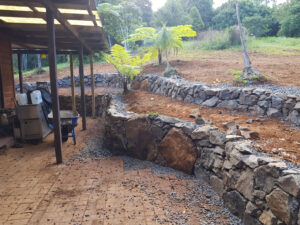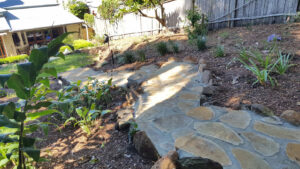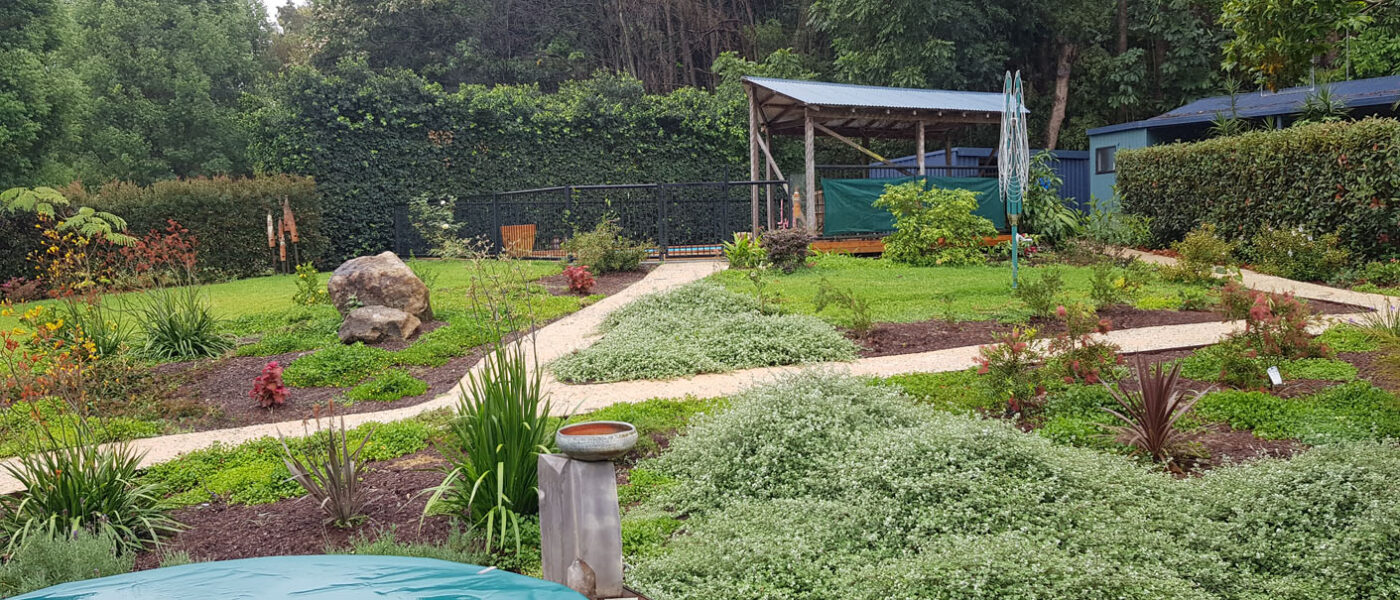Basic matters – access and gravity
By Patrick Regnault
Gardens are designed for a long lifespan. To work out the composition we need to consider not only the access to the site for the construction but also for future maintenance. In its life, the garden will need to be maintained, fertilised, mulched and green waste taken out or perhaps the garden will be in part refurbished. If the garden is difficult to access, the cost of maintaining it will rise, risking future cost-cutting and a slow decay.

Garden access, and design in general, is influenced foremost by gravity, that law governing our planet. The way surface water flows on the land dictates the need for water capture or diversion. The topography, geology and erosion will influence what we can do. Earthworks are not always a solution as they bring their own problems and are often overused.
Access to the garden is not confined to the entries and exits. The garden is a place where we sit, reflect, meander, play and socialise. To make the most of the garden we need to be able to circulate within it. Garden paths have other functions as well, be they formal or informal, as they inform the pace and atmosphere. A straight path is utilitarian going from A to B, a curved path slows us down enough to appreciate the vista, and a meandering path gives the opportunity to observe, awakening our curiosity.
The topography has a major influence on how we design and navigate our green spaces. The steeper the slope, the more essential the need to have a drainage plan. The access on a sloping garden is more crucial than on a flatter surface and must take into consideration the aesthetics, maintenance issues, drainage and possible erosion that comes with wild weather.

Surface water drainage can be a design advantage and does not need to be hidden. Swales, berms and channels can all be opportunities to create interest across, or alongside the pathway. In some cases, the drainage channels can be designed to facilitate the bringing in or removal of materials.

Steps add interest to a walk but too many short steps will make the walk difficult and the garden maintenance a nightmare. The size of the risers and the length of the treads can make the path friendly or challenging. We can learn and be inspired by the medieval town steps, which are long and sloping with short risers that were designed to make the slope manageable for walkers and also for hand-pulled carts or donkey-drawn ones. Steps can become waterfalls of high velocity if the surface water is not taken into consideration. There is a need to not let the water gain speed by capturing or diverting it. Once again this can be a great design asset. The captured water can be released to create temporary waterways, giving opportunity for interesting planting.
Ramping the garden path across the slope will make the maintenance much easier than steps but will require longer terracing and retaining walls. In turn, those walls and their associated drainage will help capture and slow the surface water. Although there is no easy way to maintain a sloped garden, a meandering sloping path is easier to use than steps when it comes to using a barrow.

The most common mistake is to have a narrow 90 degree turn on a path, especially when there are hard vertical surfaces on the sides. Barrows do not have articulated parts and knuckles are not cushioned. We need to remember that, and at times remind the owner, architect and builder of this simple fact.
Flow and gravity are great allies in garden design. We can use them to create interesting green spaces. By remembering the garden’s need to be maintained, we can lessen the stress on the body of the maintenance crew by making it an easier, more pleasant work environment. This is also an advantage to the daily users of the garden. By making access easy to any place in the garden will mean the space is used to its fullest, leaving no dark weed infested corners.
Patrick Regnault FAIH RH0062
Interactive Landscapes
E: patrickregnault@hotmail.com
Main photo: Accessing all parts of the garden to avoid ‘out-of-sight, out-of-mind’ situations (Image: Patrick Regnault)

